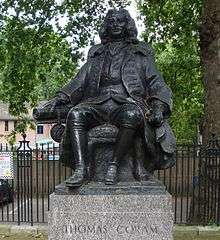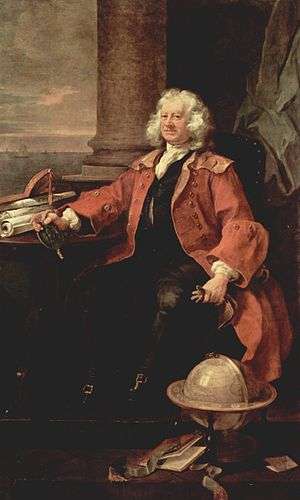Thomas Coram
| Thomas Coram | |
|---|---|
|
| |
| Born |
(c. 1668) Lyme Regis, Dorset, United Kingdom |
| Died | 29 March 1751 |
| Nationality |
|
| Occupation |
Sea Captain, Philanthropist |
| Title | Captain Thomas Hal Burken Coram |
Captain Thomas Coram (c. 1668 – 29 March 1751) was a philanthropist who created the London Foundling Hospital in Lamb's Conduit Fields, Bloomsbury to look after abandoned children. It is said to be the world's first incorporated charity.
Early life
Thomas Coram was born in Lyme Regis, Dorset, England. His father is supposed to have been Captain of a ship.[2] He was sent to sea before he was 12.[3][lower-alpha 1] In 1694 he was settled at Taunton, Massachusetts. By a deed dated the 8th of December 1703 he gave 59 acres (24 ha) of land at Taunton to be used for a schoolhouse, whenever the people should desire the establishment of the Church of England. In the deed he is described as "of Boston, sometimes residing in Taunton",[2] and he seems to have been a shipwright.[2] He gave some books to the library at Taunton, one of which, a Book of Common Prayer, given to him by Speaker Onslow, is (or was in 1844) preserved in St. Thomas' Church, Taunton.[2]
In 1704,[4] at the age of 36,[3] he settled in London,[2] and helped to obtain an act of Parliament giving a bounty on the importation of tar from the colonies. He carried on business for some time.[2] During the War of the Spanish Succession (1701–1714) he commanded a merchant ship and acquired the epithet of captain. In 1712 he obtained a role in Trinity House, Deptford, a private corporation that combined public responsibilities with charitable purposes.[4] In 1717, he unsuccessfully promoted the idea of founding a colony to be called 'Georgia' in what is today Maine as a philanthropic venture.[4] In 1719 he was stranded off Cuxhaven, when sailing for Hamburg in the Sea Flower, and the ship was plundered by the neighbouring inhabitants.[2]
He became known for his public spirit. Old Horace Walpole (afterwards Lord Walpole) called him (18th of April 1735) "the honestest, most disinterested, most knowing person about the plantations he had ever talked with".[5] He obtained an act of parliament taking off the prohibition upon deal from Germany and the Netherlands. In 1732 he was appointed one of the trustees for Georgia colony, then founded through James Oglethorpe’s exertions.[2]
In 1735 he brought forward a scheme for settling unemployed English artisans in Nova Scotia. The plan was approved by the board of trade, and after being dropped for a time was carried out before Coram's death. Brocklesby also states that on some occasion he obtained a change in the colonial regulations in the interest of English hatters, and refused to take any reward from his clients except a hat.[2]
Foundling Hospital
While living in Rotherhithe and regularly travelling into London to engage in his business interests (a journey of about 4 miles (6.4 km)), Coram was frequently shocked by the sight of infants exposed in the streets, often in a dying state. He began to agitate for the foundation of a foundling hospital. He laboured for seventeen years, and induced many ladies of rank to sign a memorial.[6] A charter was at last obtained for the Foundling Hospital, considerable sums subscribed, and the first meeting of the guardians were held at Somerset House 20 November 1739. At a later court a vote of thanks was presented to Coram, who requested that thanks should also be given to the ladies interested. Some houses were first taken in Hatton Garden, where children were first admitted in 1741. A piece of land was bought for £7,000 in Bloomsbury. Lord Salisbury, the owner, insisted that the whole of his ground "as far as Gray's Inn Lane" should be taken; but he subscribed £500 himself.[2]
The foundation stone of the hospital was laid 16 September 1742. The west wing was finished, and the children removed from Hatton Garden in October 1745. Great interest was excited in the undertaking, especially by William Hogarth, who in May 1740 presented his fine portrait of Coram to the hospital. Hogarth also presented a picture of Moses with Pharaoh's daughter, and gave tickets in the lottery for the "March to Finchley", one of which won the prize. He also introduced a portrait of Coram into an engraved power of attorney for receiving subscriptions to the hospital.[7] Handel gave performances at the hospital in 1749 and 1750.[8]
Later life

Coram continued to be interested in the hospital. In his later years he advocated a scheme for the education of Indian girls in America. After the loss of his wife he neglected his private affairs, and fell into difficulties. A subscription was raised for him. He told Brocklesby that as he had never wasted his money in self-indulgence, he was not ashamed to confess that he was poor.[9] On the 20th of March 1749 an annuity of £161. was assigned to him, the Prince of Wales subscribing £21. annually, and, it is added, paying as regularly as the merchants who were the principal contributors (the pension was transferred on Coram's death to Richard Leveridge, a retired admired singer). Coram died on the 29th of March 1751, aged 83, and was buried on the 3rd of April following in the chapel of the Foundling Hospital. An inscription was placed there, and a statue of him by William Calder Marshall was erected in front of the building a hundred years afterwards. Richard Brocklesby describes him as a rather hot-tempered, downright sailorlike man, of unmistakable honesty and sterling goodness of heart.[8]
Family
During his time in the Massachusetts that he met and married (1770) his wife. They had a happy marriage, lasting 40 years. Ironically, or perhaps it had a bearing on his great achievement, they do not seem to have had any children of their own.[4]
Legacy
Hogarth was among the first governors of the hospital. He painted a famous portrait of himself (1740; now Foundling Museum, London; reproduced in stipple by William Nutter [1754-1802] for R. Cribb in 1796), and, together with some of his fellow artists, decorated the Governors' Court Room, which contains paintings by Francis Hayman, Thomas Gainsborough and Richard Wilson. He contributed paintings for the benefit of the Foundation, and the Foundling Hospital became the first art gallery open to the public.
Handel allowed a concert performance of Messiah to benefit the foundation, and donated the manuscript of the Hallelujah Chorus to the hospital. He also composed an anthem specially for a performance at the Hospital, now called the Foundling Hospital Anthem.
The Foundling Hospital charity continues today and is known as Coram, still delivering services which transform children's lives from the same historic site. The original site also contains a children's play area, Coram's Fields, which refuses entry to adults unaccompanied by children.
In 2000, Jamila Gavin published a children's book called Coram Boy about the Foundling Hospital. The book was adapted into a play by Helen Edmundson, which had its world premiere at the Royal National Theatre in London in November 2005 and subsequently had a brief run on Broadway.
See also
Notes
- ↑ "He wrote that his mother died when he was young and he went to sea in his eleventh year, that his father remarried and moved to Hackney, and that he, Thomas, was later apprenticed by his father to a Thames-side shipwright" (Taylor 2006).
- ↑ Waterhouse 1994, p. 175.
- 1 2 3 4 5 6 7 8 9 10 Stephen 1887, p. 194.
- 1 2 Staff 1998, p. 1.
- 1 2 3 4 Taylor 2006.
- ↑ Stephen 1887, p. 194 cites Cox, Walpole, iii. 243.
- ↑ Stephen 1887, p. 194 cites "Account of Foundling Hospital", 1826.
- ↑ Stephen 1887, pp. 194–195.
- 1 2 Stephen 1887, p. 195.
- ↑ Stephen 1887, p. 195 cites Hawkins, Johnson, p. 573.
References
- Staff (1998), Thomas Coram Foundation- A brief history of the Foundation and services on the Site (PDF), ThomasCoram.Camden.sch.uk, retrieved August 2015 Check date values in:
|access-date=(help); External link in|publisher=(help) - Taylor, James Stephen (October 2006) [2004]. "Coram, Thomas (c.1668–1751)". Oxford Dictionary of National Biography (online ed.). Oxford University Press. doi:10.1093/ref:odnb/6282. (Subscription or UK public library membership required.)
- Waterhouse, Ellis (1994), Painting in Britain 1530-1790 (5th ed.), New Haven and London: Yale University Press, p. 175, ISBN 0300058330
Attribution:
 This article incorporates text from a publication now in the public domain: Stephen, Leslie, ed. (1887). "Coram, Thomas". Dictionary of National Biography. 12. London: Smith, Elder & Co. pp. 194–195.
This article incorporates text from a publication now in the public domain: Stephen, Leslie, ed. (1887). "Coram, Thomas". Dictionary of National Biography. 12. London: Smith, Elder & Co. pp. 194–195.
Further reading
| Wikisource has the text of the 1911 Encyclopædia Britannica article Coram, Thomas. |
- Harriet Amos and Alice Meyers: Thomas Coram: The Man Who Saved Children: London: Foundling Museum: 2006: ISBN 0-9551808-0-5
- Gillian Wagner: Thomas Coram, Gent: 1668-175: Woodbridge, Suffolk/Rochester, New York: Boydell Press: 2004: ISBN 1-84383-057-4
- Gillian Pugh: London's Forgotten Children: Thomas Coram and the Foundling Hospital: NPI Media Group: 2007: ISBN 0-7524-4244-9
- Jack Dwyer: Dorset Pioneers: The History Press: 2009: ISBN 978-0-7524-5346-0
External links
- OCA1947 - Old Coram Association
- Find-A-Grave profile for Thomas Coram
- Thomas Coram Research Unit
- The Thomas Coram Middle School, Berkhamsted, Hertfordshire
